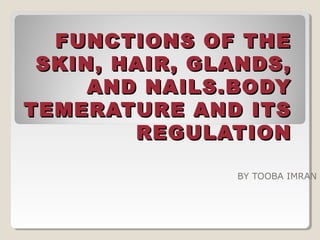
Functions of the skin, hair, glands
- 1. FUNCTIONS OF THEFUNCTIONS OF THE SKIN, HAIR, GLANDS,SKIN, HAIR, GLANDS, AND NAILS.BODYAND NAILS.BODY TEMERATURE AND ITSTEMERATURE AND ITS REGULATIONREGULATION BY TOOBA IMRAN
- 2. SKINSKIN It is the limiting membrane. Between body & environment. Skin is the largest organ of the body. Has surface area of about 1.5-2m2. It contain accessory structures: glands, hairs and nails
- 3. Body surface areaBody surface area
- 4. STRUCTURE OF SKINSTRUCTURE OF SKIN EPIDERMIS (superficial layer) DERMIS (deeper layer) HYPODERMIS (subcutaneous Layer for fat Storage).
- 5. FUNCTIONSFUNCTIONS 1. Water balance 2. Excretion of salt and metabolities 3. Regulation of body temperature 4. General sensation, e.g. touch, pain, temp. etc. 5. Acid base balance 6. Synthesis of vitamin D 7. Secretion of sweat, sebum
- 6. FUNCTIONSFUNCTIONS Storage of: 1. Fats 2. Salts 3. Glucose 4. Water, etc. Protect from external injury and bacterial invasion. Absorption.
- 7. Water balance: By perspiration (sweating) 1 EXCRETION: it is minor excretory organ Excrete water and salt as sweat. NaCl in sweat ; excessive sweating may lead to low blood sodium levels (hyponatraemia). Urea when kidney function is lost. 2 REGULATION OF BODY TEMPERATURE: Vasoconstriction Vasodilatation Sweat production SENSATIONS: Sensory receptors (nerve endings) in the skin that are sensitive to touch, pressure, temperature, pain. Stimulus come nerve impulse generate transmitted to cerebral cortex. 4 3
- 8. SYNTHESIS OF VITAMIN D: 7-dehydrochlestrol is a lipid-based substance in the skin and is converted to vitamin D by sunlight. Protection: Skin is a waterproof layer. Protect from micro-organism, chemicals, physical agents, e.g. mild trauma, ultravoilet light, dehydration. Melanin protect against UV rays. •Epidermis has immune cells (langerhans) type of macrophages. ABSOPTION: SOME DRUGS, in transdermal patches, e.g. hormone replacement therapy during the menopause, nicotine as an aid to smoking cessation. Some toxic chemicals, e.g. mercury.
- 9. ACID AND BASE BALANCE: The normal skin surface is acidic due to lactic acid, fatty acid, acetic acid present in sweat and sebum. Also the keratin layer is itself acidic.
- 10. GLANDSGLANDS 1. SWEAT GLANDS 2. SEBACEOUS GLANDS 3. CERUMINAL GLANDS
- 11. SWEAT GLANDSWEAT GLAND SWEAT It is active secretion of sweat gland. EXPLANATION: They are widely distributed through the skin and are most numerous in palms, soles, axillae and groin. The bodies of the glands lie coiled in subcutaneous tissue.
- 12. ACCLIMATIZATION OFACCLIMATIZATION OF SWEATING MECHANISMSWEATING MECHANISM Normal person produce 700 ml sweat/hr. But when exposed to hot weather sweating capability increase to 1.5-2lit/hr. This is called acclimatization of sweating. IMPORTANCE Increase sweating in hot weather removes excess heat from body. Conserve Na in body due to inc. secretion of aldosterone.
- 13. Types of sweat glandTypes of sweat gland ECCRINE SWEAT GLAND •LOCATION: Everywhere with some exception (e.g. glans penis) •SITE OF OPENING skin surface •DISCHARGE Watery, little protein, mainly water, NaCl, urea,NH3,& uric acid,. •INNERVATION Cholinergic. APOCRINE SWEAT GLAND •LOCATION Axillary, areolar and anal region •SITE OF OPENING Hair follicles •DISCHARGE Viscous, odor producing •INNERVATION adrenergic
- 14. Kinds of sweatingKinds of sweating 1. Thermal or hot sweating, due to rise of external temperature or fever. 2. Emotional or mental or cold sweating; due to direct stimulation of sweat center from higher centers in emotional states. 3. Gustatory sweating; due to stimulation of pain nerve endings in mouth by spicy food.
- 15. RELATED TERMSRELATED TERMS HYPERHIDROSIS: Increase sweating. HYPOHIDROSIS: decrease sweating. ANHIDROSIS: abnormal deficiency of sweating.
- 16. FUNCTIONS OF SWEATFUNCTIONS OF SWEAT Heat regulation, water balance Salt balance Excretion To keep skin moist and prevent it from drying. some drugs and toxins are excreted in sweat Acidic nature inhibit bacterial growth.
- 17. Sebaceous glandsSebaceous glands These are pear shaped bodies opening into roots of hair follicles. They secretes an oily antimicrobial substance, sebum into the hair follicles.
- 18. Functions of sebumFunctions of sebum Act as bacteriostatic agent; so, inhibits bacterial growth. Act as lubricant Prevents damage of epidermis during hot season Conserves heat during cold season Conserve water
- 19. FunctionsFunctions Sebum keeps the hair soft and give it a shiny appearance. Acne production. Collect dirt.
- 20. CERUMINAL GLANDSCERUMINAL GLANDS Cerumen is a yellow, pasty substance secreted by ceruminal glands of external auditory canal. NOTE:NOTE: accumulation of cerumen deep In auditory canal may interfere with hearing.